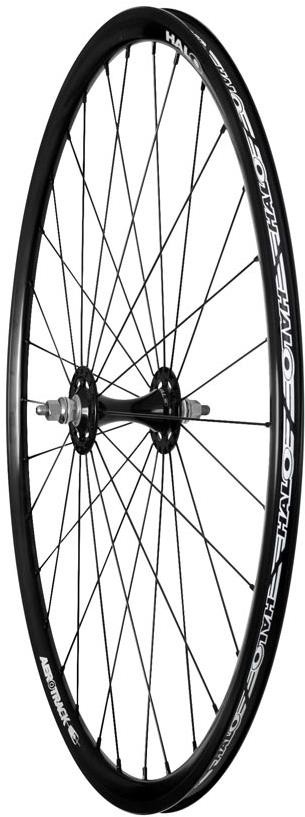Halo Aerotrack 700c Front Road Wheel

- Using the outstanding Halo (120mm width) track hubs and built using 32 plain 14 gauge spokes combined with the Halo Aerotrack Mid size Aero road rim.
- Light and strong with an attractive mid size 27mm Aero section.
- Front - 900g
- Rear - 956g
- Featuring Halo's ever popular Aerotrack 700c rims laced to the Fix-G HG-splined fixed hub.
- Innovation meets reliability in the form of these 700c, 120mm spaced rear wheels.
- Available in White powder coated, Silver or Black, with Fix-G/Freewheel or Fix-G/Fixed hub options.
- An ever present headache with normal fixed hubs is the assembly of a drive cog that is attached by a thread being pulled in both directions by the pedal torque. Of course, the traditional solution to avoiding the cog unwinding itself from the hub in the reverse direction is a left hand threaded lock-ring, butted up tight against the cog. But, as many riders have found out, this historic system can be relatively volatile.
- A splined hub body (with cogs that slide on) and an independent lock-ring that never has to handle rotational forces from the drive.
- The Halo Fix-G hub features a fixed HG spline, machined as part of the alloy main hub body*, with a conventional internal thread for a standard HG type lock-ring (with easy tool fittings). Options available for the left hand side include conventional fixed or freewheel threads.
- Easy and secure fixing & servicing.
- Adjustable chain-line.
- Twin cog option (can run 2 cogs together.)
- Accepts from 12T + cogs (for compact gearing).
- No need for chain-whip tools.
- Hi-polish custom CNC machined hub shell,
- HG type fixed spline.
- Japanese sealed bearings.
- Hollow M10 Cr-Mo axle.
- 120mm spacing.
- 22mm "Large cone-faces" to avoid damage to frame.
- includes cog spacers and alloy lock-ring.
- Front Axle Thread 9x1.
- Rear Axle Thread 10x1.
- Laser logo. 32H, 36H or 48H
- HG Fixed/Fixed or HG Fixed/Freewheel types.
Ivan Fiorilla - 5th Floor riding club - London. The5thfloor.co.uk
- Our hubs must only be used with ISO standard 1.29" x 24TPi L/H fixed cog lock-rings.
- Do NOT USE French (1.32" x 24TPi) or Italian (33 x 1mm) standard lock-rings.
- The larger diameter French and Italian lock-rings may appear to work but will strip the threads from the ISO hub.
- For correct fixed use, the fixed sprocket should NEVER move on the hub when pedal force is applied in both directions. If the sprocket moves, then something is wrong and continued use with a fixedsprocket that moves will result in damage to the hub.
Occasionally, without notice, manufacturers change product design and/or specifications.
Customer reviews and Q&A's are disabled because you declined functional cookies.
To enable reviews and Q&A's click the 'Cookie Settings' button below and enable functional cookies.
Halo Aerotrack 700c Front Road Wheel
Cycle to Work is a salary sacrifice scheme, where you can save up to 42% off a new Bike and Safety equipment. This means the cost is deducted from your salary as a non-cash benefit, so you save on tax and national insurance.
Here at Tredz, we accept Cycle to Work vouchers from all national schemes. For more information click here.
At Tredz, we’re committed to bringing you the best products at the best prices. If you find a product cheaper elsewhere, simply contact us for an immediate response using our live chat service. Click here to discuss your price match with an agent now for help.
Subject to Terms and Conditions
At Tredz, we offer a fast high quality service, with a range of options from free delivery on orders over £30, next day and convenient click & collect from one of our stores. Simply select within the checkout.
*Courier deliveries to Northern Ireland, Isle of Man, Isle of Wight, Channel Islands and the Scottish Highlands/Islands will incur a charge.When you receive your bike, all you'll need to do is unpack it, attach the pedals, turn the handlebars and ride.
To help you get started we have put together a handy Bike Building Guide, click here.
At Tredz, if you are not 100% happy with your order, then you can use our simple hassle free returns service. Simply return the item new and unused in the manufacturers original packaging within 365 days of purchase. Bikes and larger items are collected by courier.